Code is deprecated and not supported anymore. Please go to https://github.com/zalandoresearch/psgan for a newer version.
##############
This code implements Spatial Generative Adversarial Networks (SGANs) on top of Lasagne/Theano, as published in the paper https://arxiv.org/abs/1611.08207
The code was tested on top of Lasagne (version 0.2.dev1) and Theano (0.9.0dev2).
SGANs can generate sample textures of arbitrary size that look strikingly similar - but not exactly the same - compared to a single (or several) source image(s).
- SGANs can be thought of as a convolutional roll-out of Radford et al.'s deep convolutional generative adversarial networks for texture synthesis
- the fully convolutional nature allows for real-time generation of high resolution images
- the method can fuse multiple source images and is highly scalable w.r.t. to output texture size and allows for generation of tiled textures
You can generate samples from a stored model. E.g. you can use the checked-in model:
python demo_generation.py models/barcac_filters64_npx257_5gL_5dL_epoch50.sgan
This model was trained on a google maps image of barcelona, and yields a texture image like e.g. this
It will also create a tilable periodic texture of the city, which is another capability of our SGAN model. You can look at the script and tune how big textures you want to create, by changing the parameters NZ1 and NZ2.
To train the model on new images, edit the config.py file and set the texture_dir variable to a folder containing the image(s) you want to learn from. You might also want to change other parameters of the network there (e.g. depth, number of filters per layer etc...). Then run
python sgan.py
to train the model. Snapshots of the model will be stored in the subfolder models/ and samples after each epoch will be stored in samples/
- Urs Bergmann (ursbergmann@gmail.com)
- Nikolay Jetchev (nikolay.jetchev@zalando.de)
- Roland Vollgraf (roland.vollgraf@zalando.de)
Please make sure to cite/acknowledge our paper, if you use any of the conatained code in your own projects or publication: Nikolay Jetchev, Urs Bergmann, and Roland Vollgraf. Texture synthesis with spatial generative adversarial networks. CoRR, abs/1611.08207, 2016. https://arxiv.org/abs/1611.08207
The MIT License (MIT)
Copyright © 2016 Zalando SE, https://tech.zalando.com
Permission is hereby granted, free of charge, to any person obtaining a copy of this software and associated documentation files (the "Software"), to deal in the Software without restriction, including without limitation the rights to use, copy, modify, merge, publish, distribute, sublicense, and/or sell copies of the Software, and to permit persons to whom the Software is furnished to do so, subject to the following conditions:
The above copyright notice and this permission notice shall be included in all copies or substantial portions of the Software.
THE SOFTWARE IS PROVIDED "AS IS", WITHOUT WARRANTY OF ANY KIND, EXPRESS OR IMPLIED, INCLUDING BUT NOT LIMITED TO THE WARRANTIES OF MERCHANTABILITY, FITNESS FOR A PARTICULAR PURPOSE AND NONINFRINGEMENT. IN NO EVENT SHALL THE AUTHORS OR COPYRIGHT HOLDERS BE LIABLE FOR ANY CLAIM, DAMAGES OR OTHER LIABILITY, WHETHER IN AN ACTION OF CONTRACT, TORT OR OTHERWISE, ARISING FROM, OUT OF OR IN CONNECTION WITH THE SOFTWARE OR THE USE OR OTHER DEALINGS IN THE SOFTWARE.

_(2%2C%203).jpg)